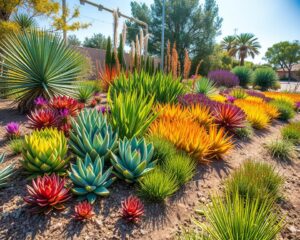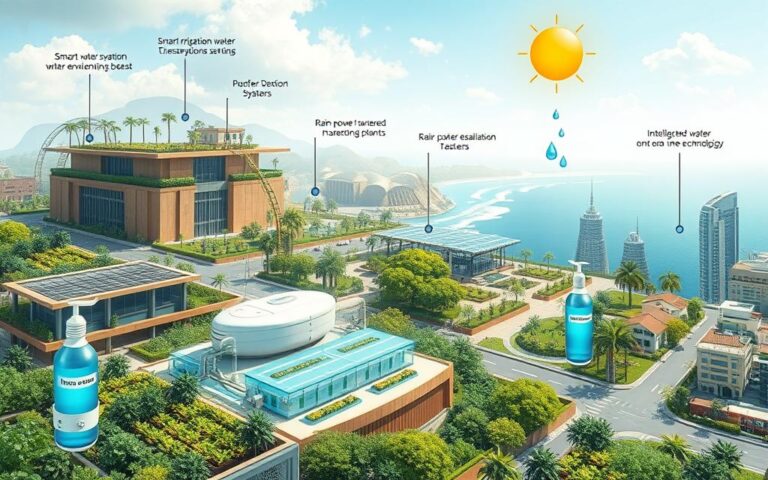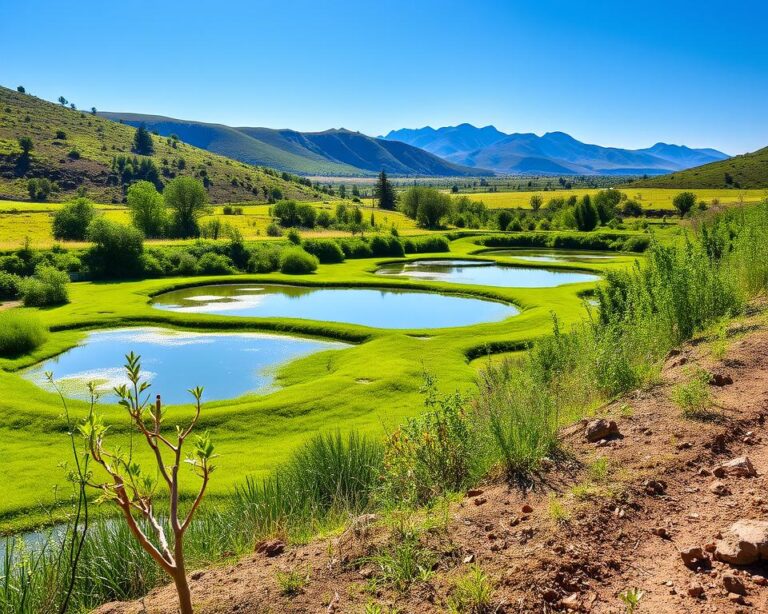In December 2020, the United States saw its largest drought area since 2012. This shows how urgent it is to save water as the climate changes. About 81% of the country was dry at the 2012 drought’s peak. We need to use water wisely to protect it.
Water conservation is key, and using water-saving methods can help a lot. Choosing drought-resistant plants for your garden is a smart move. These plants need less water and are perfect for dry areas. Saving water helps your garden and supports a bigger effort to be green and strong against environmental issues.
Understanding Water Conservation
Water conservation means using water wisely to protect our planet. It helps ensure that future generations have enough water. Making small changes in our daily lives can greatly help the global water crisis. By taking care of water, we save money and help the environment.
What Is Water Conservation?
Water conservation is about using water smartly to cut down on waste. Using plants that need less water can save a lot of water. These plants can use up to 50% less water than regular plants.
Using the right irrigation methods can also help. This way, gardens can grow well without wasting water.
Why It Matters to You
Water conservation is important for many reasons. It helps the environment and saves you money. In California, about 9% of water is used for gardens.
Knowing that half of home water goes to gardens shows how much we can save. By conserving water, we help keep it available for everyone. We also make our community stronger.
The Global Water Crisis
The world is facing a big water problem, made worse by climate change and more people. About 2 billion people live in areas with very little water. Bad water management makes things worse.
Switching to water-saving methods can help. By being responsible with water, we encourage others to do the same. This leads to big changes for the better.
The Impact of Climate Change on Water Resources
Climate change is changing water resources in the United States. As temperatures rise, communities face new weather challenges. These changes cause more droughts and floods, harming local ecosystems.
Changing Weather Patterns
Weather patterns are shifting due to climate change. The north may see 20% more rain, while the southwest could see 20% less in summer. These changes make it hard to manage water resources.
Unpredictable rain, caused by human activities, adds to the problem. It makes planning for water harder for communities.
Droughts and Flooding
Droughts in the west and south have caused over $6 billion in damage. This shows we need to tackle climate change’s impact on water. Droughts threaten food and raise water prices.
Flooding can harm farms and cities. Water shortages might lead to fights over water, making sustainable management crucial.
Effects on Your Community
Your community is also affected. Water shortages can impact daily life and farming. Rising sea levels could change where cities grow.
Understanding these impacts is key. Your community’s water future depends on taking action to reduce risks.
Daily Habits That Waste Water
Many everyday practices waste a lot of water. Knowing these habits helps you save water. This can save money and help the environment.
Common Household Water Wastage
Simple mistakes can waste a lot of water. A leaky toilet can waste gallons every day. Long showers use a lot of water, up to five gallons a minute.
Flushing items like cigarette butts or tissues wastes at least 1.6 gallons per flush. Using less water, like filling the bathtub only halfway, can save a lot.
Overwatering Your Lawn
Watering your lawn too much is common. Sticking to a schedule ignores natural rain. Watering deeply in cooler times helps roots grow.
Children playing with hoses or sprinklers can waste a lot of water. Finding the right balance in watering saves water in all weather.
Inefficient Appliances
Old appliances use a lot of water. Upgrading to water-efficient ones saves a lot. Low-flow toilets use less water per flush.
Running dishwashers only when full saves water and energy. Fixing leaks quickly saves thousands of gallons a year.
Simple Ways to Conserve Water at Home
Small steps at home can make a big difference in saving water. You can use many ways to save water, like fixing leaks and using less water. These actions help lower your water bills and protect the environment.
Fixing Leaks
Leaky faucets and toilets waste a lot of water. A dripping faucet can waste 20 gallons a day. It’s important to check and fix leaks to save water and money.
Installing Water-Efficient Fixtures
Choosing water-efficient fixtures is a smart move. For example, a new toilet can save up to 70% of water per flush. Energy Star clothes washers use 35-50% less water than old ones. These changes help save water and keep your home modern.
Rainwater Harvesting
Rainwater harvesting is a clever way to use natural water. It helps with watering gardens and lawns, cutting down on city water use. This method saves water and supports a green garden.
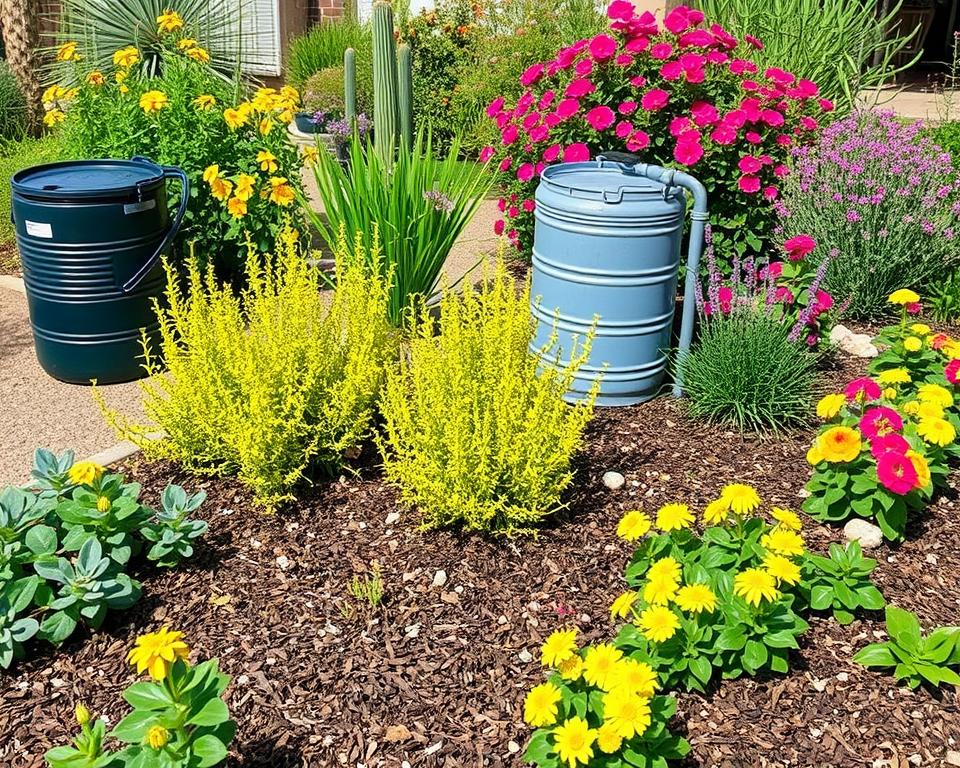
| Action | Estimated Water Savings | Details |
|---|---|---|
| Fix a leaky faucet | 20 gallons/day | Common issue that can be easily repaired. |
| Install low-flow toilets | Up to 70% savings | Significantly reduces water usage per flush. |
| Upgrade to high-efficiency washers | 35-50% less water | Also reduces energy use. |
| Implement rainwater harvesting | Varies | Utilize for irrigation and landscaping. |
| Use drip irrigation | Up to 90% efficiency | Minimizes evaporation and runoff. |
By using these simple water-saving tips, you help protect this vital resource. You’ll also enjoy lower bills and a greener lifestyle.
The Role of Agriculture in Water Usage
Agriculture is a big user of water worldwide. It’s important to manage water well. Sadly, 70% of the world’s freshwater is used for farming. This is because water-intensive crops need a lot of water.
Up to 40% of this water is wasted. This happens because of old farming systems and evaporation. We need new ways to use water better.
Water-Intensive Crops
Not all crops use the same amount of water. For example, beef and dairy use a lot more water than grains. The water needed for beef is 20 times more than for grains.
This shows we need to choose crops wisely. We should pick ones that use less water.
Sustainable Farming Practices
Using sustainable farming can save a lot of water. For example, using compost can increase tea yields by 20%. This is because compost helps plants grow better.
Also, better ways to handle wastewater can increase coffee yields by 21%. These methods help plants grow and save water.
Importance of Drip Irrigation
Drip irrigation is key for saving water in farming. It delivers water slowly to the roots. This cuts down on evaporation and runoff.
Studies show it can save a lot of water. Using drip irrigation can reduce water loss and boost crop yields. It makes sure we use every drop of water.
| Crop Type | Average Water Footprint (liters per day) | Water Footprint per Calorie |
|---|---|---|
| Dairy Cow | 170 | High |
| Beef Cattle | 95 | Very High |
| Pigs | 30 | Moderate |
Using sustainable farming and drip irrigation is key. It helps meet food needs and save water. Farmers are crucial in protecting our water.
The Importance of Native Plants in Landscaping
Using native plants in landscaping has many benefits. It makes gardens look good and helps the environment by using less water. It also makes gardens more durable and healthy.
Benefits of Xeriscaping
Xeriscaping uses plants that fit well with local weather, using less water. Choosing the right native plants means they grow well without too much water. Even though some native plants need water, knowing what they need is key to a successful xeriscaped garden.
Reducing Water Need for Gardens
Choosing plants that fit their conditions can cut down water use. For example, Missouri Evening Primrose does well in dry spots, while swamp milkweed likes wetter soil. This knowledge helps create gardens that are good for the planet and use less water.
Encouraging Local Wildlife
Using native plants in your garden brings in local wildlife. Adding plants like Agastache, Penstemon, and Ratibida makes your garden a home for birds, butterflies, and insects. This makes your garden more beautiful and helps the environment.
| Native Plant | Preferred Condition | Water Needs |
|---|---|---|
| Missouri Evening Primrose | Dry conditions | Low |
| Swamp Milkweed | Consistently moist soil | Moderate |
| Agastache | Well-drained soil | Low |
| Penstemon | Dry to medium soil | Low |
| Ratibida | Dry conditions | Low |
Engaging Your Community in Water Conservation
Creating a strong water conservation culture needs community involvement. By getting residents to join in, you boost awareness and encourage green habits. Local clean-ups and workshops are great ways to do this. They unite people and teach them to care for the environment.
Organizing Local Clean-Up Events
Local clean-ups are a great way to get people involved in saving water. They help clean up waterways and teach about waste. It’s a hands-on way to show how we can all help the environment.
Educational Workshops and Programs
Workshops are perfect for teaching about water-saving gardening. They cover topics like using rainwater and saving soil moisture. By learning together, people can save more water and help their community.
Sharing Resources Online
The internet is a great tool for sharing water-saving tips. Social media and local websites can spread the word about saving water. It helps people learn from each other and work together to save water.
| Initiative | Potential Impact | Community Engagement Level |
|---|---|---|
| Local Clean-Up Events | Reduce pollution and promote environmental awareness | High |
| Educational Workshops | Increase understanding of sustainable practices | Medium |
| Online Resource Sharing | Enhance knowledge and networking | High |
The Economic Benefits of Water Conservation
Water conservation brings big economic wins. It saves money on bills and helps the planet. Using green tech boosts these gains, making our economy and environment stronger.
Lower Water Bills
One big plus of saving water is cheaper bills. Simple steps like using water-saving gadgets and smart irrigation can cut costs. For example, water-saving appliances and zero-scaping reduce water use, saving you money each month.
Economic Resilience in Drought Conditions
Water shortages are expected in 40 states by 2024. Being ready is key. Drought-tolerant crops and smart irrigation save a lot of water. This helps farmers and keeps communities stable, especially in areas where most water is used.
Investment in Sustainable Technologies
Green tech is a smart investment. Methods like conservation tillage and crop rotation save water and boost soil health. They make farming more profitable by using resources wisely. Adding organic matter to soil also helps it hold water, supporting the ecosystem and the economy.
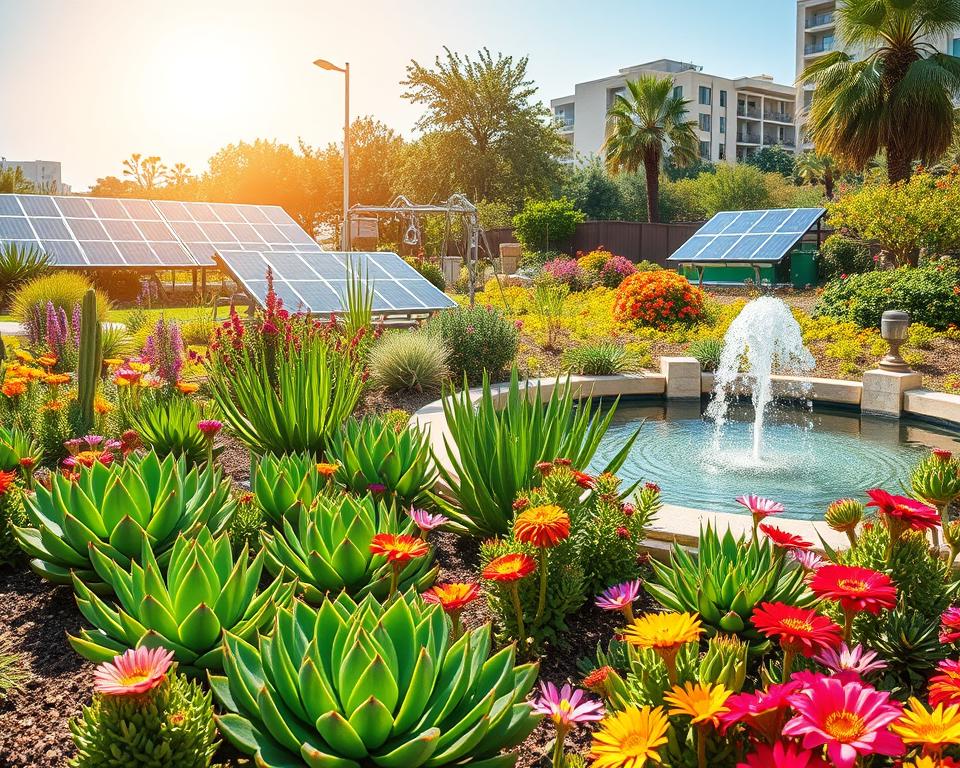
Government Policies and Water Conservation
It’s key to know how government policies affect water conservation. Laws can set rules for using water wisely. By combining good laws with incentives, we can make a big difference for our planet and people.
Existing Legislation Impacting Water Use
Many laws control how we use water, aiming to keep it safe. These rules cover things like how we water plants, the water’s quality, and how to save it. How well these laws work depends on how much people know and care about them.
Incentives for Water-Efficient Practices
Government incentives help people and businesses save water. They offer things like tax breaks for water-saving devices and money for green gardens. Knowing about these incentives can encourage you to make changes that help save water.
Advocating for Change in Your Community
Being active in your community can lead to better water laws. Local efforts can push governments to make stronger rules. By getting involved, like going to meetings or starting campaigns, you can make a big difference.
| Government Policies | Potential Impact | Examples of Incentives |
|---|---|---|
| Water Conservation Legislation | Regulates water usage based on guidelines | Tax credits for water-efficient appliances |
| Urban Water Use Regulations | Sets limits on usage for city landscapes | Grants for community garden initiatives |
| Agricultural Water Policies | Promotes sustainable farming practices | Low-interest loans for irrigation upgrades |
The Future of Water Supply
The future of water supply is linked to new technology and understanding our ecosystems. Water recycling and desalination are key in meeting growing water needs. It’s crucial to educate communities about these sustainable practices.
Innovations in Water Recycling
Water recycling is becoming a vital solution for managing water. It reuses wastewater, easing the pressure on traditional water sources. In dry areas, this method is especially useful for saving water.
Efficient recycling facilities can treat greywater for irrigation and industrial use. This boosts the future of water supply.
Desalination Technologies
Desalination is another promising way to improve water supply. It turns seawater into drinking water, helping to meet population needs. Despite initial costs and environmental concerns, research is making it more efficient.
As desalination technology advances, it will become a vital part of our water supply.
The Role of Education in Sustaining Water Supplies
Education is essential for using water supply innovations effectively. Teaching communities about water conservation and recycling empowers them. It helps them make better water use choices.
Through education, we can build a sustainable culture. This awareness is crucial for protecting water for future generations.
Personal Responsibility in Water Conservation
Being responsible with water is key to keeping it for future generations. By tracking your water use and setting goals, you can make a big difference. Leading by example helps create a sustainable culture around you.
Tracking Your Water Usage
Knowing your daily water use is the first step to saving it. The average U.S. person uses about 110 gallons a day. Most of this is for toilets, baths, and laundry. By keeping track, you can find ways to use less.
Small changes like shorter showers or using low flush toilets can save a lot. Low flush toilets use 1 to 2 gallons per flush, compared to 3 to 5 gallons for regular ones.
Setting Water Conservation Goals
Setting goals helps you see how much you’ve saved. Try to use less water each day. Simple steps like watering your lawn in the morning or using an Energy Star washing machine can make a big difference.
Even small changes add up over time. Try to use 10 gallons less water each day as a personal challenge.
Leading by Example
Your actions can inspire others. Show off your eco-friendly habits, like using drought-resistant plants. These plants need less water and make your space look great.
When everyone works together, we can make a big impact on our water resources. Your efforts can help protect our water for the future.
| Water-Saving Practices | Water Usage Reduction |
|---|---|
| Low Flush Toilets | 70% savings |
| Energy Star Washing Machines | 35-50% savings |
| Drip Irrigation | 25-50% savings |
| Watering Early Morning | Reduces evaporation |
| Drought-Resistant Plants | Minimizes watering needs |
Conclusion: Your Role in Water Conservation
Your role in saving water is huge. Think about how you use water every day. Look at using water-saving appliances and plants that don’t need much water. Every choice you make helps save water for everyone.
Reflecting on Your Practices
Think about how you use water and how it affects our future. Simple changes like mulching or using drip irrigation can save a lot of water. Even small changes can make a big difference and inspire others to do the same.
Inspiring Others to Take Action
Being dedicated to saving water can motivate others in your community. Share what you’ve learned about water-saving plants and efficient watering. Join local events to teach others and work together to save water.
Committing to a Sustainable Future
Make a promise to help our planet by saving water. Encourage your loved ones to join you in saving water. Together, we can make a big change and protect our water resources for the future.

